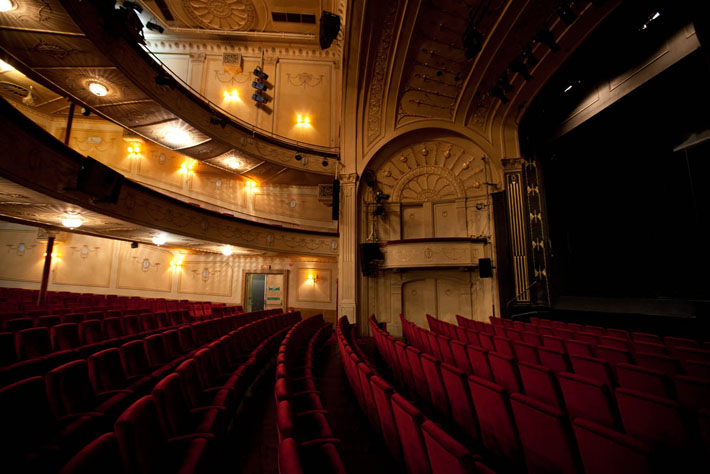
A glimpse into Australian history with Melbourne’s historic Athenaeum Theatre as it was once upon a time many moons ago
As one of Victoria’s oldest public institutions, Australia’s Melbourne Athenaeum was first founded in 1839. The heritage building was originally called the Melbourne Mechanics’ Institute, an educational facility which taught various technical disciplines.
In 1873, the name was changed to the Melbourne Athenaeum and the front of the building received a major rebuild from 1885-1886.
In 1896, The Melbourne Athenaeum became the first theatre to ever show a movie in Australia. This milestone became a pivotal moment for the venue which began to regularly screen films through until 1921. From then on, the theatre began hosting a range of theatrical and creative performance shows.
Over ninety years on and today, the Melbourne Athenaeum is home to the Melbourne Theatre Company, while hosting a slew of acts ranging from theatre productions to comedy festivals to concerts year round.

Melbourne’s Athenaeum Theatre today over 90 years on…
With this iconic Australian venue due for a complete sound overhaul, one of the Athenaeum’s owners Glenn Elston wanted an audio solution that would be able to handle the highly varied range of acts that grace the Athenaeum’s stage. The Athenaeum regularly hosts comedy, dramatic theatre, opera, acoustic performances, rock shows, musicals and everything in between.
Normally, an installation caters for the largest production needs and scales down on a show-by-show basis. However with the Athenaeum being a heritage, wedding-cake style theatre, the venue did not lend itself to large systems, either flown or ground stacked. In addition, Glenn was after a system that would be able to cater for all these different performances, while being easily reconfigured by his in-house tech staff.

The theatre has a fantastic and relaxed intimate feel
A combination of distributed and small form-factor systems from Coda Audio, Camco amplification, mixing from DiGiCo consoles, plus DSP from Xilica Audio Design and Apex Audio were specified for the installation. This, combined with a thorough infrastructure update, gave the Athenaeum enough flexibility and power to continue on; delighting varying audiences into the future. The concept was to have a high-powered distributed system, one that would not impact visually on the heritage theatre, while still allowing different zoning and system configuration to cater to the many types of clients that hire the theatre.
With Coda offering a range of loudspeakers which are ultra compact and high output, the decision to go with Coda made a lot of sense given the theatre’s beautiful interior didn’t need to be filled with huge speaker footprints throughout. Additionally, with the entire Coda range using BMS drivers exclusively, voicing uniformity was much better matched, even across the various models used throughout the installation. This is critical in well designed theatre installations as dispersion and tonal evenness throughout the entire venue is paramount.
Looking for a complete, no-compromise system, the theatre installation was carried out with a high level of configurability and forethought in order to keep up with the Athenaeum’s versatility as a venue. Melbourne’s RTR Productions carried out the entire installation of the system.
Group Technologies’ Drew Menard reflected. “RTR really had their hands full with a theatre like the Athenaeum. It was obviously from an era where cabling and rigging weren’t meant to be easy.”
New cable runs meant having installation technicians crawling through unbelievably tight spaces. Many other installers would be happy with running some surface-mount conduit on each level; but that was unacceptable for RTR. “Having high performance speakers this small meant that we could put them in some fantastically tight locations. Luckily Mitch was a master at ferreting out ways to get through the walls.”

After additional consultation with Matt Hanson from MPH Australia with regards to rigging, Drew continued. “Matt is one of the most respected riggers in the country, and had no problems dealing with all of the Athenaeum’s intricacies.” All of the original structural members are enormous timber beams. Even in a building as old as this, Matt was millimetre perfect.”
The main front of house PA includes 4 x LA4 modules and 1 x LA4 Sub flown per side. 4 x LA4 subs were also installed along the front of the stage. The LA4 is an extremely impressive miniature line array system that features two 5″ neodymium BMS drivers and Coda’s patent pending 4″ neodymium planar wave driver. The result is a highly efficient and scalable array system capable of very high output for its size.
x D5 Cubes which were installed against the front lip of the stage and the proscenium fill is now handled by a single Coda G712 per side. The Coda G712 speakers are a true full range 3 way speaker system utilising a 12″ neodymium driver and a concentric 1.4″+1.75″ driver.
The delay for the stalls are comprised of 4 x D5 Cubes which are spaced evenly from left to right half way down the theatre.

The dress circle on the second level has a completely different layout than the other two levels and needed a different approach. While both the ground floor and the top level feature long aisles and plenty vertical height, the second level dress circle has a very narrow vertical opening between the two balconies. There is a strong rake as well which made it challenging to get high frequencies to the back of the area. Instead of installing an LA4 line array which was chosen for the ground floor and in the upper dress circle, 2 x Co-Ray column speakers per side were used instead. These line source columns feature the same drivers as the LA4, but are used as two single line source columns. In this configuration, the two columns flown top-to-top feature a vertical dispersion of 22 degrees, while the adjustable horizontal dispersion of the Co-Ray ensure a full, focused sound can be provided to patrons seated in the dress circle without causing any sight line issues, and help alleviate reflections from the side walls. An additional 4 x D5 cubes were also used for delays to cover up to the walkway behind the raked seating.
The upper balcony includes a similar setup to the stage level system and includes 4 x LA4 modules and 1 x LA4 Sub flown per side as well an additional 4 x D5 cubes for delay.
The D5 cubes are a concentric 5″+1″ coaxial speaker with an exceptionally small footprint, high output and very sweet sound. They are perfect for theatre installations as they extremely subtle. At the Athenaeum they have been installed either by themselves or on truss between existing lighting fixtures throughout the theatre. This ensured an extremely low visual profile for the delays.
The Athenaeum now also features a versatile range of options in order to configure the system appropriately based on the show requirement. This was achieved with a combination of Coda and Camco amplification coupled with Apex and Xilica system management.
There are sixteen speaker zones throughout the venue and each speaker zone is fed by one of Coda’s dedicated DNC260N controller. These deliver proprietary advanced DSP and speaker management to each zone.
Four Apex Intelli-X 2 Z48 processors then provide complete frontend control for time alignment, system tuning and EQ management.
To manage all the matrix feeds, one of Xilica’s latest digital audio processors, a Neutrino A-1616, has been installed. This is a completely open-architecture 16 x 16 40bit floating point processor. This unit has been configured with room presets comprised of different speaker configurations depending on the show requirements. This allows the in-house technicians to decide on different tuning presets to suit their client, and then also mute different zones depending on what parts of the theatre are being utilised. A Xilica wall panel (the MiniS8), features 8 control buttons that can be programmed simply by dragging a parameter on the panel using Xilica’s intuitive software package – NeuConsole.
Amplification across the system is handled by Camco Vortex 6 amplifiers for the arrays and columns, a Camco DPower4 amplifier for the G712’s in the proscenium, and the D5 cubes are powered by Coda C5 amplifiers.
With the room completely configured with several practical preset options, Glenn has been very impressed with the quality of sound and the simplicity of operation. “It’s great to just be able to walk in, turn it on, and have world class sound without having to do anything except flick a switch. I am really happy with everything.”

With the entire PA being upgraded, it was only fitting that a new front of house console was added to match. Mixing and monitoring duties are now handled by a DiGiCo SD9 with 2 x D-Racks. There is certainly little that needs to be said about the DiGiCo SD Series as its popularity in the theatre, live and broadcast markets has continued to skyrocket over the past decade. Since the installation, the technicians have found the 64 mic inputs on stage more than enough to cover their clients’ needs. There are 24 outputs on stage as well. These can feed the 4 sends of Nexo PS10R2 monitors, or multiple sets of in-ear monitors.

The DiGiCo SD9’s flexibility has been paramount to helping the Athenaeum cater to the many different types of shows brought in. With 16 (and soon to be 24) stereo busses able to be either groups or auxiliaries, and an additional 12×8 matrix, the SD9 feels equally home in rock-n-roll, drama, or musical theatre. That’s all before considering the future upgrade path of adding the dedicated theatre software. The DiGiCo ‘T’ theatre software has been developed with leading West End Sound Designer Andrew Bruce and has been used on countless productions including Les Mis, Miss Saigon, Jersey Boys, Lion King, and Warhorse.
Glenn was particularly impressed with the final solution. “The installation was done really well. It really fits with the venue aesthetically. The column speakers on the balcony follow the lines of the building perfectly. It doesn’t intrude on the interior of the theatre at all.”

In addition to equipment, a substantial infrastructure update was also delivered. This included the earlier mentioned speaker cable runs, as well as considerable amounts of analogue signal, MADI, video BNC, Ethernet, DiGiCo CAT5E and power cabling between the stage patch position and front of house. Further additions to make a technicians’ life easier were included such as new rack mounted 3phase power distribution, a rack-mounted pc, screen, and keyboard for further system editing. This all enables touring shows to use in house cabling for all of their FOH cable runs, and use any other mixing console if desired. All this has been done to allow simple reconfiguration from a standard L/R input patch, to full 16 input matrix patching for musical theatre. Combine this with the SD9T’s matrix nodal delay, and the designers have complete -and automatable- control over audio and effect placement.

Since the installation, the Athenaeum has been receiving rave reviews and extremely positive feedback from theatre companies, bands and engineers alike as Glenn further commented. “The sound is absolutely brilliant. We have been receiving regular compliments from clients and patrons. It’s just fantastic.”









































